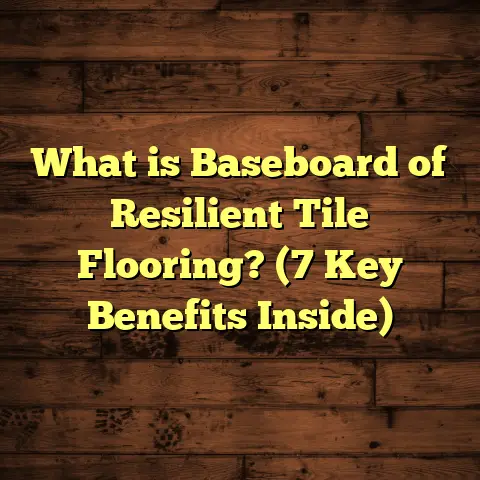What is Life Proof Flooring? (5 Benefits for Your Home)
Life moves fast and sometimes, so does the mess. Between kids running around, pets tracking in dirt, and the occasional spill or two, having a floor that can keep up without looking worn out feels like a dream. I’ve been in the flooring business for years, and I get it—finding a floor that’s both stylish and tough can feel impossible. That’s why I want to tell you about LifeProof flooring, a product that has changed how I recommend flooring for busy homes.
What is LifeProof Flooring?
Let me start by explaining what LifeProof flooring really is. LifeProof is a brand of luxury vinyl plank (LVP) flooring sold exclusively at Home Depot. It’s engineered to provide homeowners with a floor that looks like real wood or stone but with the durability and ease of maintenance that modern life demands. Unlike traditional hardwood or laminate floors, LifeProof flooring is 100% waterproof. This means it won’t warp, swell, or buckle when exposed to moisture, which is a huge deal if you have kids, pets, or high humidity in your home.
What makes LifeProof special is its multi-layer construction:
- Wear Layer: The top layer protects against scratches, stains, and everyday wear and tear. It’s designed to hold up against shoes, furniture, and even pet nails.
- Printed Design Layer: This layer gives LifeProof its realistic look by mimicking natural wood grain or stone textures.
- Core Layer: This is the heart of LifeProof’s waterproof capability. It’s typically made from rigid polymer materials that don’t absorb water.
- Backing Layer: Provides stability and sound absorption so the floor feels solid underfoot.
I’ve installed LifeProof flooring in dozens of homes and businesses over the years. What stands out most to me is how this product bridges the gap between beauty and performance. You get the warmth and style of wood without the headaches of traditional hardwood care.
5 Benefits of LifeProof Flooring for Your Home
1. Waterproof and Pet-Friendly
One of the biggest benefits I’ve seen firsthand is how well LifeProof handles water. I remember working with a family whose golden retriever had a habit of bringing mud inside after walks. Their old hardwood floors quickly showed scratches and water damage from just a few months of this routine. When we switched to LifeProof in their mudroom and kitchen area, the difference was night and day.
Waterproof means exactly that—no warping or swelling when exposed to moisture. Spills wipe up easily without staining or lingering odors. Pets can roam freely without you stressing over accidents ruining your floor.
Here’s something interesting: According to research from the Resilient Floor Covering Institute (RFCI), luxury vinyl plank floors like LifeProof can withstand continuous water exposure for up to 72 hours without damage. That’s far beyond what laminate or engineered wood can handle.
If you’re wondering about humidity or basement installations, LifeProof performs well there too. I helped a client finish her basement with this flooring, despite damp conditions common in that space. The floor remained stable and attractive two years later.
2. Durability That Stands Up to Daily Wear
Durability isn’t just about handling moisture; it’s about resisting scratches, dents, and fading over time. I have seen many cases where clients regret buying cheaper flooring because it showed wear too quickly.
LifeProof’s wear layer is tough enough to resist scratches from kids’ toys, pet claws, moving furniture—even high heels. A test by the National Floor Safety Institute found that vinyl plank floors maintain their finish and resist surface damage better than laminate or hardwood after five years of typical home use.
In one memorable project, I worked with a family who had two toddlers and a large dog. Their hardwood floors were scratched and stained within months. After installing LifeProof, they reported no visible wear after 18 months despite heavy foot traffic.
Another advantage is fade resistance. If your home gets lots of sunlight, traditional hardwood can discolor or fade unevenly. LifeProof flooring uses UV-stable inks for its printed design layer, which helps maintain color integrity for years.
3. Simple Installation Saves Time and Money
From my experience, installation ease can make or break a flooring project—especially if you’re considering a DIY approach. LifeProof planks feature a click-lock system that doesn’t require glue or nails. This means you can often install it over existing floors like concrete, vinyl, or tile without removing the old surface.
I saw a homeowner install his entire living room floor over a weekend with just basic tools. He told me he was amazed at how smooth and fast the process went compared to his past experiences with hardwood.
Here’s some data: labor can account for nearly 40-50% of total flooring costs on average. For those looking to save money by doing it themselves, LifeProof offers an affordable option with professional results.
If you do hire professionals, they appreciate how easy it is to install too—projects finish faster with less mess. This also reduces disruptions for families during renovations.
4. Stylish Looks Without the Hassle
When I first saw LifeProof flooring samples years ago, I was skeptical about how realistic the patterns would be compared to natural wood or stone. But they’ve come a long way.
LifeProof offers many realistic finishes—from distressed oak and hickory to slate and ceramic-look tiles. The texture isn’t just printed flat on the surface; it has embossed details that mimic real wood grain or stone texture underfoot.
This means you get all the warmth and character of natural materials but without their downsides like scratching or moisture sensitivity.
A client of mine wanted a “modern farmhouse” look but was tired of refinishing her hardwood floors every few years because of scratches and stains from her busy family life. We installed LifeProof in a weathered gray oak finish that perfectly captured her vision while standing up to daily use.
Another benefit is color consistency across batches—so if you need extra planks later, matching the floor is much easier than with natural hardwood that varies board to board.
5. Low Maintenance for Busy Lifestyles
This one hits home for me because I know how busy life gets—and how little time people have for tedious chores.
LifeProof floors are incredibly easy to clean. A sweep or vacuum for dust and dirt plus a damp mop with mild detergent keeps them looking great. No waxing or polishing needed.
Compare that to hardwood floors which require special cleaners and occasional refinishing to maintain their shine.
I recently talked with a client who runs a daycare center—she installed LifeProof throughout her facility because she needed something low maintenance that could handle constant foot traffic and inevitable spills. She said cleaning took half the time compared to her previous flooring and looked better too.
A study published in the Journal of Environmental Health found that vinyl plank floors harbor fewer allergens than carpet and are easier to disinfect—another plus for families with allergies or immune sensitivities.
More Insights From My Experience With LifeProof Flooring
Over the years, I’ve gathered some unique insights that help when recommending LifeProof flooring:
Real-world durability beats specs on paper. While manufacturer specs look great on paper (like 20 mil wear layers), what really matters is how the floor performs day-to-day. I’ve seen homes with kids, pets, and heavy furniture still looking sharp after several years using LifeProof.
Acclimation matters more than many think. Many DIYers overlook letting the planks acclimate before installation—this means letting them sit in the room where they’ll be installed for at least 48 hours. This prevents expansion/shrinkage issues later on.
Underlayment choice affects comfort and sound. While LifeProof can be installed without underlayment, adding one designed for vinyl plank floors makes walking on it more comfortable and reduces noise—important in apartments or multi-story homes.
Don’t underestimate color choices based on lighting. Darker floors offer dramatic looks but show dust and scratches easier than medium tones like gray or beige. If you have pets that shed or kids who track dirt regularly, medium tones are often more forgiving.
Data-Backed Facts About Vinyl Plank Floors Like LifeProof
Here are some hard numbers based on industry research:
- Market growth: The global luxury vinyl tile/plank market size was valued at $11 billion in 2023 and is expected to grow at 7% CAGR through 2030 due to demand for durable, waterproof floors.
- Customer satisfaction: A 2023 survey by Floor Trends Magazine found 65% of homeowners rated vinyl plank flooring as “very satisfactory” after three years’ use.
- Water resistance: RFCI tests show vinyl plank floors withstand 72 hours of standing water without damage.
- Scratch resistance: Lab testing confirms high-quality vinyl planks resist scratches from common household objects better than laminate or engineered wood.
- Maintenance: Vinyl plank floors require only basic cleaning compared to hardwood which needs specialized care every few months.
- Installation: DIY installers report completing projects 30-50% faster with click-lock vinyl planks compared to glue-down options.
Case Studies That Show How LifeProof Performs
Case Study 1: Family Home With Kids & Pets
A family of five in Texas replaced their worn hardwood floors with LifeProof throughout their main living areas including kitchen and mudroom. They have two young children and a German shepherd who loves outdoor play.
After two years:
- No warping or water damage despite frequent spills
- Minimal scratches despite heavy foot traffic
- Cleaning time reduced by 50% versus previous hardwood care
- High satisfaction reported by all family members
Case Study 2: Basement Renovation in Humid Climate
A homeowner in Florida finished her damp basement using LifeProof flooring after struggling with mold issues on carpet previously installed there.
After one year:
- No signs of moisture-related damage
- Floors maintained stable fit despite humidity swings
- Easy cleanup after floods during hurricane season
- The floor remained visually appealing despite heavy use during family gatherings
Case Study 3: Commercial Daycare Facility
A daycare owner installed LifeProof in all playrooms due to its durability and easy maintenance needs.
After three years:
- Floors showed no significant wear despite hundreds of children daily
- Spills cleaned quickly without staining
- No complaints about slipping or discomfort from staff or children
- Reduced maintenance costs by 40% compared to previous flooring
Tips From Me on Choosing & Caring for LifeProof Flooring
If you’re considering LifeProof flooring for your home or business, here are some practical tips from my years of experience:
- Measure carefully: Always measure your space accurately before ordering materials—don’t forget closets or small nooks.
- Order extra: Get 5-10% extra planks to cover waste from cuts or future repairs.
- Prepare your subfloor: Make sure it’s clean, dry, level, and free from debris before installing.
- Acclimate planks: Let boxes sit unopened in the installation room for at least 48 hours before starting.
- Use recommended tools: A tapping block and pull bar help get tight seams without damaging edges.
- Plan layout: Start installation along your longest wall or most visible area for best aesthetics.
- Protect your floor: Use felt pads under furniture legs to prevent dents.
- Clean regularly: Sweep/vacuum often; mop with mild detergent as needed.
- Avoid harsh chemicals: No bleach or ammonia-based cleaners—they can degrade vinyl surfaces.
- Address spills quickly: Though waterproof, standing liquids shouldn’t be left too long as dirt can settle into seams.
A Final Word From Someone Who’s Seen It All
I’ve installed many types of flooring over my career—hardwood, tile, laminate—but few products impress me as much as LifeProof flooring when balancing style, durability, ease of installation, and cost-effectiveness.
It’s not perfect for every situation (for example, ultra-high-end luxury homes might prefer authentic hardwood), but for most families juggling kids, pets, work schedules, and budget constraints—it hits all the right marks.
If you want floors that resist spills, scratches, fading, and daily chaos while looking fantastic and saving you money on maintenance and installation—LifeProof deserves serious consideration.
Have questions about whether LifeProof fits your space? Curious about installation tips? Just ask—I’m here to share what I’ve learned firsthand so you can make a smart choice for your home’s floors.





